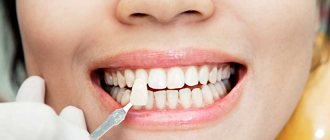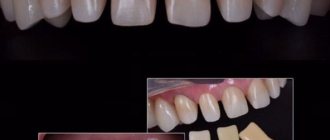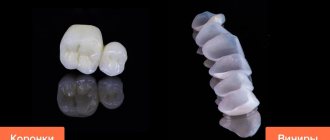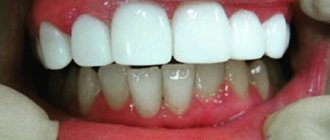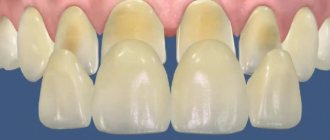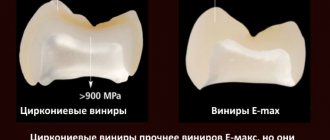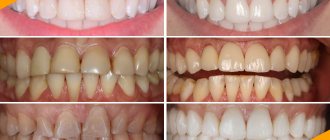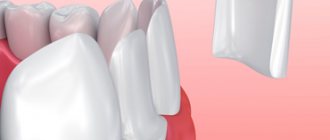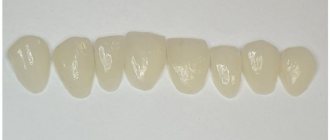Componeers – these are ready-made linings made of nanohybrid composite, durable, light and porous. Unlike individually made veneers, componeer is made according to a sample, resulting in a relatively low cost of the product. By agreeing to the installation of composites, a person gains the opportunity to quickly change his appearance - to cover with a composite, like a shield, uneven tooth surfaces, cracked enamel and other imperfections in the smile area.
Nowadays, the range of compositors presented in dentists’ offices is extremely diverse. Therefore, for any patient, the doctor will select a product that matches the color and shape of natural teeth.
When to use componeer
Componers are used in cases where the patient wants to correct dental defects with veneers. Like other products of a similar nature, componers perform similar functions:
- Mask fillings on the front part of the tooth;
- Eliminate diastemas and interdental gaps, improving the aesthetics of the smile;
- They hide dark, spotted teeth under their surface;
- Restore chipped enamel and worn-out dental units;
- They hide the imperfections of crooked teeth, set at an angle or creeping onto neighboring ones;
- Replaces the teeth whitening procedure.
Componers successfully combine the advantages of two techniques – direct composite veneering and installation of ceramic indirect onlays. A ready-made template is taken and glued to the tooth in the dentist’s office. As a result, the patient's time and money are saved.
An innovative patented veneering method was the appearance in dental practice of Luxneers veneers - veneers without preparation for the front teeth. With them it is possible to correct any imperfections in the color, shape and some degree of curvature of the teeth without drilling, anesthesia and pain.
Indications and contraindications
Fastening direct composite onlays is recommended in a number of cases and eliminates the need for the manufacture of expensive ceramic veneers and labor-intensive work using the method of direct restoration of dentition elements.
Among them it is necessary to note:
- diagnosing caries, the development of which has led to the destruction of areas between teeth and in the cervical area;
- slight degree of dystopathy;
- discoloration of natural enamel and the need for its bleaching;
- identification of defects in the form of direct bite, diastema, rotation of dentition units, three;
- increased abrasion of enamel, which causes the rapid development of caries;
- masking fillings and preventing further destruction of the dentofacial apparatus;
- identification of chips, cracks resulting from injuries, accidents and other types of mechanical impact;
- the need to eliminate gaps between teeth.
The decision on the advisability of installing composites is made by the attending physician, who assesses the condition and individual characteristics of the patient’s dental system.
In case of violation of the contact of the upper and lower rows of the dental system, detection of the consequences of bruxism and dysfunction of the masticatory muscles, periodontal inflammation or a significant area of destruction of natural crowns, the method of artistic restoration with direct composite onlays is not used.
How to install componers
Installation of the nanocomposite compositor occurs in stages:
- The doctor, together with the patient, decides on the color of the plate.
- The dentist applies a special gel called try-on gel to the veneer. It is flimsy and only serves to demonstrate what the template looks like in a row of teeth. If the selected color does not match, the template is removed and the gel is washed off. The procedure is repeated with a sample of a new shade.
- If the characteristics satisfy the doctor and the patient, the gel is replaced with medical cement identical in color, which strengthens the composite on the tooth.
- The shape of the componer is subject to correction. It remains possible to correct the color with a special color scheme.
Indirect porcelain veneers involve multiple visits to the office, first to take impressions, then to try them on, and finally to place lumineers, or porcelain veneers, on your teeth. Therefore, the process of acquiring a beautiful smile lasts for weeks, sometimes reaching one and a half months.
At the same time, when choosing an indirect veneering technology, the patient is deprived of the opportunity to influence the choice of plate shade or control the work of technicians in the laboratory. The selection of compositors and subsequent installation are advantageously reduced due to the availability of ready-made molds and the absence of the need to use the labor of laboratory technicians and the operation of expensive equipment.
Differences between lumineers and compositers
We work only with high-quality dental products from international companies and global brands. Componeers and Lumineers are innovative types of the thinnest veneers, their thickness is 0.3 mm.
| Characteristics | Lumineers (USA) | COMPONEER |
| Material | ultra-strong ceramics | nanohybrid composition |
| Fastening | special glue | micro-retention (non-smooth) surface increases bond strength |
| Strength | high | slightly lower |
| Aesthetics | shine, immunity to coloring products | may change color over time, require polishing 1-2 times a year |
| Scope of work | restoration of 6–12 teeth | restoration of 1–2 crowns |
| Life time | 5–7 years | up to 20 years |
| Replacement, complete removal | possible | |
| Price | higher | available |
What is the difference between preparing teeth for restoration with veneers and composites?
The general stage of preparation for installing both types of plates on the patient’s teeth includes thorough sanitation of the oral cavity. Professional cleaning is carried out, plaque and stone are removed. If necessary, caries is treated.
The differences are few, but they are large in character and perception by the patient. For example, gluing composites most often does not require preliminary grinding of a living tooth. In exceptional cases, a minimal area sparing effect is performed.
Of the orthopedic veneers made in dental laboratories on machines, only Luxneers veneers and American lumineers do not require turning.
When applying plates to the surfaces of several dental units, the process begins with the front central teeth in the row. The final result depends on the correct execution, so the action takes 1.5 - 2 hours. The more templates are expected to be placed, the more time the patient will spend in the dental chair, but the procedure is always completed in one clinic visit.
To install ceramic veneers (not luxeers, lumineers), it is necessary to first cut down part of the enamel. The tooth is prepared from all sides, including the cervical part, lateral surfaces, cutting edge and back side. Subsequently, it is no longer possible to remove the veneer, since the organ is prepared as much as possible.
The patient will have to visit the doctor several times; the procedure includes both a clinical and laboratory stage. If the dentistry is located in another city, you will have to add transportation costs to the cost of treatment.
Advantages and disadvantages of composite veneers
Componer advantages:
- veneers made of composite materials are fixed without tooth preparation;
- installation is carried out in just one step;
- The cost of composite veneers is typically lower than their porcelain counterparts because there is no need for impressions and custom fabrication in a laboratory setting.
If you are planning composite veneers for a long time, you will encounter these not very pleasant moments:
- Composite veneers are not as ideal as ceramic ones; they can be matched to the color of the natural tooth enamel.
- The service life of componers is about five years.
- Composite veneers are stained by food coloring and darken and lose their shine over time.
- Componers are not able to withstand adequate chewing load. Possible chips.
- It is necessary to grind and polish composite veneers to restore the lost shine.
Disadvantages of Composers
The technology has an extremely small number of disadvantages, which allows patients to often resort to installing ready-made plates.
- For example, since 2011, the date of the introduction of veneers into dental practice, sufficient material has not yet been accumulated to talk about the durability limits of these veneers. However, the expected lifespan is 5-10 years.
- Componers are not intended to correct dental deficiencies. They can only cover up unwanted small deformations.
- If compositors are installed on the upper row of teeth and completely cover the smile area, it is often necessary to use whitening of the lower teeth to achieve a harmonious appearance.
- Componers do not always fit tightly to the teeth and caries forms underneath them, followed by tooth destruction.
Why are microprostheses needed?
Thin onlays are used only to improve the appearance of teeth. They correct the color of the enamel when it is impossible to achieve the desired whitening using other methods, for example, with “tetracycline” teeth. Lumineers hide dark fillings and chipped enamel, mask the gap between the incisors (diastema) and minor deviations in the position of the teeth. Onlays strengthen teeth, but do not protect against caries.
COMPONEER and lumineers are installed only on the front teeth, healthy or cured. Before microprosthetics, it is necessary to undergo caries treatment, get rid of tartar, and, if necessary, cure stomatitis and periodontitis.
Benefits of installing componeer
Often people are slightly intimidated by the fact that a componer is a template form. Each person is unique, and the patient is worried that the new artificial tooth will be too different from the others, clearly demonstrating its own unnaturalness.
However, a competent dentist will dispel the patient’s fears when he voices a list of the advantages of the technique:
- The products are presented in a variety of options. You can choose the shape and color, which makes it possible to select componeers individually.
- There is aesthetics that meets high demands. Teeth corrected with onlays look natural and do not differ from natural ones. At the same time, they are noticeably inferior in aesthetic beauty to Hollywood veneers.
- It is possible to change the color and shape of teeth. If you are unwilling or unable to perform whitening, it is easy to get a snow-white smile by installing composites.
- The reasonable cost of template veneers makes them competitive in comparison with expensive ultraneers and lumineers, and the speed of installation often becomes decisive in the choice of correction method.
- The price of composite veneers is slightly higher than the installation of composite veneers. But the latter require regular polishing, and nanocomposite veneers look like new even after years.
- Veneers cannot be repaired, only replacement is allowed. Componeers can be repaired by partial chipping right in the patient's mouth.
- The records do not require sophisticated care. Enough with the usual hygiene. Moreover, the onlay reduces the risk of caries by preventing the accumulation of bacteria on the front wall of the tooth.
Installation process
As soon as the surgical site is dry and there is excellent visual access to the units being restored, the doctor begins to install composite veneers.
The procedure takes place in stages and includes the following manipulations:
- the product is removed from its personal packaging, the parameters are checked, correction is carried out using a dental grinder operating at low speed (if the pad is not suitable in width or length);
- checking the fit of the product along the gingival margin;
- cold abrasive treatment to improve surface adhesion;
- treating the enamel with an acid-based etching agent, followed by rinsing with warm water (after half a minute);
- air drying;
- applying a thin layer of a universal self-priming adhesive system to the enamel;
- fastening transparent plates (matrices) with subsequent polymerization of the adhesive on the outer protective layer of the unit (half a minute);
- uniform distribution of the adhesive agent over the inner shell of the product and the protective layer of the tooth;
- attaching the attachment to the restored specimen using medical tweezers;
- the use of special silicone instruments for high-quality fitting of the lining in the cervical area and along all contours;
- checking the exact installation of the product using a special device, usually an occlusal marker;
- treatment of the onlay with a dental polymerization lamp for rapid adaptation of tooth tissue to the product;
- eliminating composite excess using a bur with a diamond grinding attachment;
- final corrective actions to check the correct position of the lining relative to the axis and length of the dental unit;
- polishing manipulations in the cervical area, checking the contact of the teeth of the upper and lower jaw;
- bringing the surface of the composite veneer to a sparkling shine using a bristled device treated with carborundum;
- application of a fluorine-based product that performs protective functions against the aggressive effects of coloring pigments.
The process of attaching Swiss onlays is considered complete after assessing the final result of the restoration and receiving advice on further hygienic care.
The video shows the process of installing compositors.
